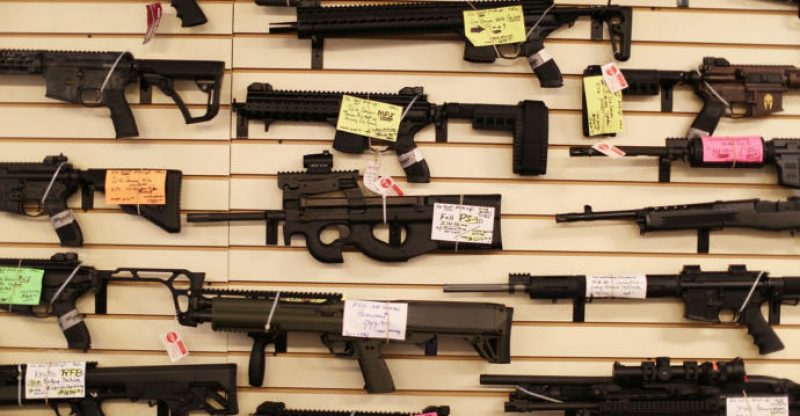Sanity from the Courts on Gun Control in a Time of Trump
 In our country, assault weapons have become the subjects of limitless and absurd gun-fetishist metaphysics, of the medieval angels-and-pins kind.CreditPHOTOGRAPH BY JOE RAEDLE / GETTY
In our country, assault weapons have become the subjects of limitless and absurd gun-fetishist metaphysics, of the medieval angels-and-pins kind.CreditPHOTOGRAPH BY JOE RAEDLE / GETTY
It may be small comfort to read a court decision rooted in the desire to prevent another Newtown-style massacre from happening at a time when the President of the United States is eager to listen to a figure from beyond the lunatic fringe like Alex Jones, who claims that the school shooting in Newtown, Connecticut, never happened at all. But in two court decisions this week, one in Virginia and one in Florida, the fight for gun safety, not to mention gun sanity, continues. The decisions are cheering not only because of their content—which, if not likely to much lower the level of gun violence, is still likely to save the lives of many children—but because of their explanatory manner, their judicial style. In both cases, clear and articulate argument is made, and, for the moment, won, against the same kind of frenzied dishonesty, and the same toxic brew of authoritarian absurdity parading as libertarian choice, that have helped propel Donald Trump to power.
In the first case, the Fourth Circuit Court of Appeals, sitting in Richmond, affirmed the right of the state of Maryland to ban the sale of forty-five kinds of military-style weapons and to limit the size of the magazines that they contain. In doing so, the judges made the limits of the Supreme Court’s Heller decision, from 2008—which, by a 5–4 vote, discovered a previously undetected individual right to own guns in the language of the Second Amendment—more firmly defined than ever.
In our country, assault weapons have become the subjects of limitless and absurd gun-fetishist metaphysics, of the medieval angels-and-pins kind. What is an assault weapon? You don’t know what an assault weapon is! If it isn’t a fully automatic machine gun, how can you call it one? It may look like an assault weapon—but that is only to the deluded eye of the cosmopolitan gun hater. It may look like an assault weapon but its inner soul is merely that of a rifle! Maybe all guns are assault weapons! The argument seems to be that, failing some essential definition of an assault weapon, no assault weapon can be believed to exist—not only should they not be banned, they cannot be banned because they are not a fixed, eternal category in the mind of the God of guns.
Fortunately, the Fourth Circuit spoke up clearly, in exactly the way wise nominalists always did back in the eleventh century. They enumerated rather than essentialized. Here’s a list of the things that military-style assault weapons have that other kinds of guns don’t, they said, and, while these things make killing people on a battlefield easier and more lethal, they are not features that are necessary to defend home and hearth—unless you somehow expect your home and hearth to come under attack from an armed division.
Are the banned weapons significantly “like” the military ones that even Heller admitted, grumpily, and under the pressure of Justice John Paul Stevens’s great dissent, were subject to the people’s will, the court asked? (And it went on, with a certain amount of deadpan judicial humor, to go into the dictionary definition of “like.”) The claim, frequently made, that the great divide is between whether a weapon is automatic or semiautomatic is not relevant as to whether it is designed to be a military weapon. “The very features that qualify a firearm as a banned assault weapon—such as flash suppressors, barrel shrouds, folding and telescoping sights, pistol grips, grenade launchers, night sights and the ability to accept bayonets and large-capacity magazines” serve specific, combat-functional ends, the opinion noted. In turn, large-capacity magazines are meant to provide soldiers with a large ammunition supply and the ability to reload quickly and “enable a shooter to hit multiple human targets very rapidly.” (As the court no doubt knew, some children at Newtown survived because the moment they ran in terror coincided with the moment the gunman changed magazines. The decision states, “In all, the gunman fired at least 155 rounds of ammunition within five minutes, shooting each of his victims multiple times. Both before and after Newtown, similar military-style rifles and detachable magazines have been used to perpetrate mass shootings in places whose names have become synonymous with the slaughters that occurred there.”) The counterargument, by the minority of dissenters, is essentially that if a lot of civilians are buying military weapons, you can’t really call them military weapons any longer. As the decision remarks, with a nice withering turn, this makes gun legislation a “popularity test”; if enough people had machine guns, you would have to legalize machine guns.
The second decision, the so-called Docs vs. Glocks ruling in Florida, issued this week, passed from the mere metaphysics of gun ownership into a special land of the loony known only to the National Rifle Association. The Florida legislature had been prodded by the N.R.A. to pass a law preventing physicians, with pediatricians especially in mind, from even suggesting to their patients that it might be a good thing for the family’s health to keep the guns away from the kids. The Florida court found this an absurd attempt to use the Second Amendment to squash the First. Doctors, the judges said, should be free to give advice as they want to (and their patients are free to ignore that advice as they choose).
There is, again, at this moment, an even greater emergency than gun violence facing the country: that of having a radically anti-American Administration, hostile to principles of pluralist democracy, and, as George Will rightly pointed out this week, devoted instead to reactionary European ideals of blood, folk, and authority. This circumstance calls for alliances across the ideological spectrum; those of us who are deeply devoted to the issue of gun sanity ought to be willing to postpone arguing it again, if it impedes the formation of a coalition of the otherwise sane. (One would hope, perhaps forlornly, that our conservative allies would feel the same way about the fight against Roe v. Wade.) And yet, there is not only relief but a lesson about constitutional balance in the gun decisions. In both decisions, what is most impressive is the tone of the legal reasoning that gives rise to them. Even the most diehard assault-rifle lover, at least one willing to read with an open mind, might be impressed by the sound and style of the Fourth Circuit’s decision—its care, its meticulous detail, its careful reasoning, its ability to fairly and charitably sum up opposing views, its readiness to concede uncomfortable truths. (Essentially all handguns, the ruling makes clear, are, like it or not, still protected by Heller.) All of this is the sound of judicial review doing the work that judicial review is meant to do. That we have a reservoir of American jurists capable of asserting the centrality of careful and equitable reasoning—not merely, or, these days, especially, on the Supreme Court but throughout the land—and of making clear decisions by clear majorities, is heartening here, as it was heartening in the recent case of the refugee ban. In a time of mad unreason, where high power babbles and stammers, the cautious eloquence of our courts affirms their independence. It’s a sound we need to hear.







